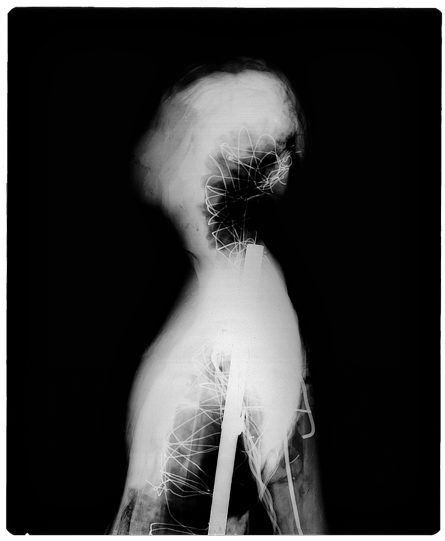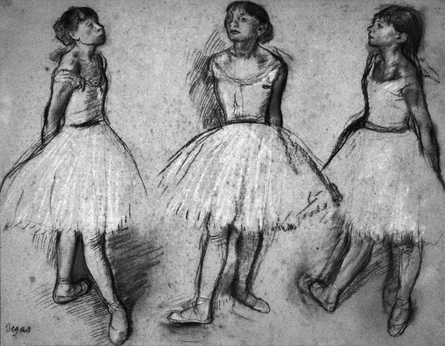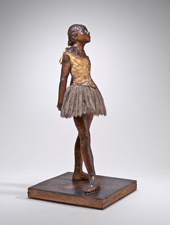From these clay and wax layers, more pronounced in the front, a possible evolution of the dancer’s features can be surmised. Perhaps the most surprising metamorphosis visible on the radiograph is seen on the profile image of the head (see fig. 1). An internal core of the same clay that was used in the legs retained the modeled shape of a smaller head, including facial features.[1] This is the vestige of an earlier attempt by Degas at modeling the dancer’s physiognomy. Interestingly, this early version is upright, lacking the slight tilt and raised chin so characteristic of the finished Little Dancer. Degas’s drawings (see fig. 2) also reflect changes to the shoulders, placement of the arms, and shape of the nose, perhaps the same kinds of modifications he felt necessary as he modeled the sculpture. However, neither drawing records alterations to the tilt of the head, which Degas must have determined directly on the sculpture as he worked. Recording a contemporary observation purportedly by Auguste Renoir, Ambroise Vollard wrote that the dancer’s mouth had been changed: “And that ballet dancer in wax! . . . The mouth . . . just a suggestion, but what drawing! What’s the name of that old fool . . . that friend of Degas’ who does nudes that look as if they’re moulded. . . . He kept after Degas until he finished that mouth, and of course he spoiled it.”[2]
Little Dancer Aged Fourteen
Technical Notes: Internal Construction
Technical Notes: Exterior Construction
Study in the Nude of Little Dancer Aged Fourteen (Nude Little Dancer)
Fourth Position Front, on the Left Leg
Technical Notes: Internal Modifications

Fig. 1: Degas, Little Dancer Aged Fourteen, detail of radiograph, showing head in profile

Fig 2: Degas, Three Studies of a Dancer in Fourth Position, 1879/1880, charcoal and pastel with stumping, and touches of brush and black wash, on greyish-tan laid paper with blue fibers, laid down on gray wove paper, The Art Institute of Chicago, Bequest of Adele R. Levy, 1962.703 Photography © The Art Institute of Chicago
To adapt the proportions of the entire figure to accommodate the finished shape of the head, Degas enlarged portions of the sculpture. Both shoulders appear to have been raised about 4 centimeters by adding many thin layers of wax. The change in height is also obvious at the neck where the previously noted spring, approximately 3 centimeters long, was added at the top of the vertical lead pipe to lengthen the neck and raise the head. These adjustments to the figure’s height help explain the placement of the short rod perpendicular to the central pipe below the chest, which appears to offer little structural significance, but in a smaller-scale sculpture the rod could have defined their location and supported the shoulders.
Notes
1. A sample of the grayish clay was found to be the same as that used for modeling Head, Study for a Portrait of Mme Salle. Michael Palmer, Analysis Report, March 29, April 17, 2002, NGA conservation files.
2. Ambroise Vollard, Degas: An Intimate Portrait, trans. Randolph T. Weaver (New York, 1986), 59, with elisions and punctuation that differ from the original French, given in Vollard, Degas (1934–1917) (Paris, 1924), 63: “Et cette danseuse, en cire. . . . Il y avait là une bouche, une simple indication, mais quel dessin! Malheureusement, à force de s’entendre dire: ‘Mais vous avez oublié de faire la bouche!’ C’était ce serin de . . . Je ne peux décidément trouver aucun nom, aujourd’hui . . . Cet ami de Degas qui fait des femmes nues qui ont l’air d’être moulées sur nature et qui doivent l’être sûrement . . . Enfin, d’être tellement embêté pour cette -bouche, il l’a faite: c’était plus ça!”
